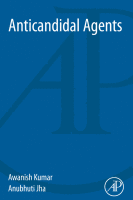Browse content
Table of contents
Actions for selected chapters
- Full text access
- Book chapterAbstract only
Chapter 1 - Introduction
Pages 1-5 - Book chapterAbstract only
Chapter 2 - Host–Pathogen Interaction
Pages 7-10 - Book chapterAbstract only
Chapter 3 - Antifungals Used Against Candidiasis
Pages 11-39 - Book chapterAbstract only
Chapter 4 - Drug Resistance in Candida
Pages 41-47 - Book chapterAbstract only
Chapter 5 - Multidrug Resistance and Transporters
Pages 49-54 - Book chapterAbstract only
Chapter 6 - Potential Anticandidal Targets
Pages 55-61 - Book chapterAbstract only
Chapter 7 - Drug Development Strategies
Pages 63-71 - Book chapterAbstract only
Chapter 8 - Conclusion
Pages 73-74 - Book chapterNo access
Abbreviations
Pages 75-76 - Book chapterNo access
Bibliography
Pages 77-83
About the book
Description
Anticandidal Agents provides the latest information on candida drug resistance and its remedial implications. In this compilation, users will find a comprehensive view on overcoming resistance in anticandidal drugs, along with information on novel molecules.
Candida albicans is an opportunistic pathogenic fungus responsible for life threating invasive and nosocomial infections across the globe. Candidiasis is a major cause of morbidity among immunocompromised patients. Infections caused by non-albicans candida like C. glabrata, C. parapsilosis, and C. tropicalis have also imposed a serious threat in the last few decades. Current treatment of candidiasis relies primarily on antifungal agents broadly categorized as azoles, polyenes, echinocandins, allylamines, and pyrimidines.
Lately, antifungal resistance has emerged to be an obstruction of current treatment regime. A number of reasons are described in detail. Understanding the mechanisms of resistance is crucial for developing strategies for overcoming the hindrance in current therapeutics.
Anticandidal Agents provides the latest information on candida drug resistance and its remedial implications. In this compilation, users will find a comprehensive view on overcoming resistance in anticandidal drugs, along with information on novel molecules.
Candida albicans is an opportunistic pathogenic fungus responsible for life threating invasive and nosocomial infections across the globe. Candidiasis is a major cause of morbidity among immunocompromised patients. Infections caused by non-albicans candida like C. glabrata, C. parapsilosis, and C. tropicalis have also imposed a serious threat in the last few decades. Current treatment of candidiasis relies primarily on antifungal agents broadly categorized as azoles, polyenes, echinocandins, allylamines, and pyrimidines.
Lately, antifungal resistance has emerged to be an obstruction of current treatment regime. A number of reasons are described in detail. Understanding the mechanisms of resistance is crucial for developing strategies for overcoming the hindrance in current therapeutics.
Key Features
- Presents a complete understanding of candida resistance to help in the development of therapeutic expansion and novel drugs
- Provides thorough information on candida drug resistance and its remedial implications
- Covers crucial mechanisms of resistance that will help develop strategies for overcoming the hindrance in current therapeutics
- Presents a complete understanding of candida resistance to help in the development of therapeutic expansion and novel drugs
- Provides thorough information on candida drug resistance and its remedial implications
- Covers crucial mechanisms of resistance that will help develop strategies for overcoming the hindrance in current therapeutics
Details
ISBN
978-0-12-811311-0
Language
English
Published
2017
Copyright
Copyright © 2017 Elsevier Inc. All rights reserved.
Imprint
Academic Press
